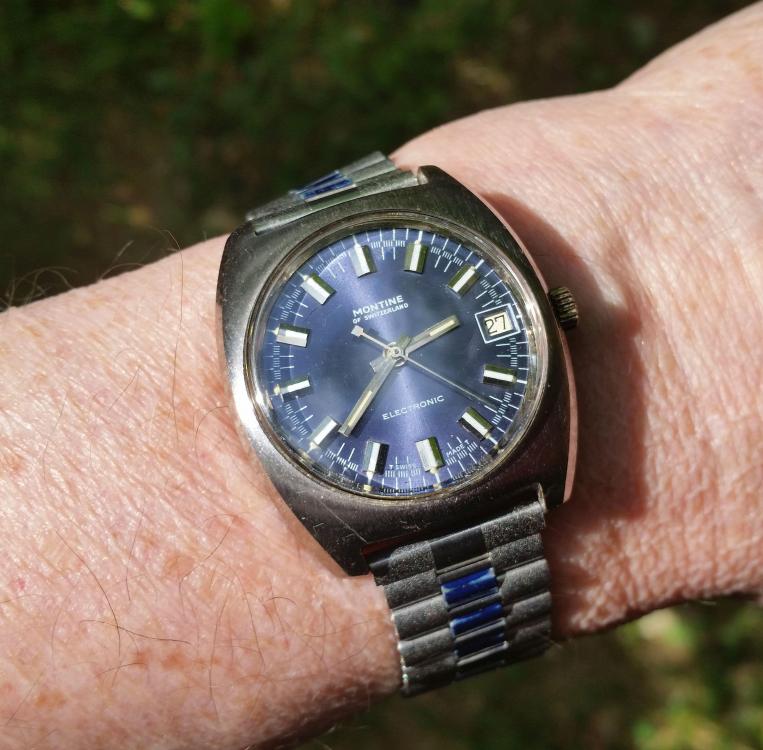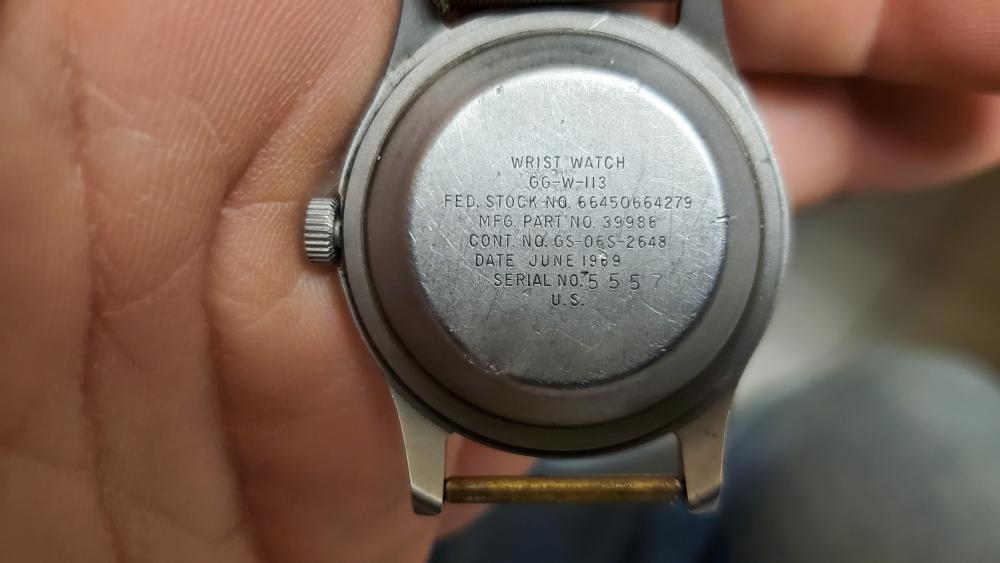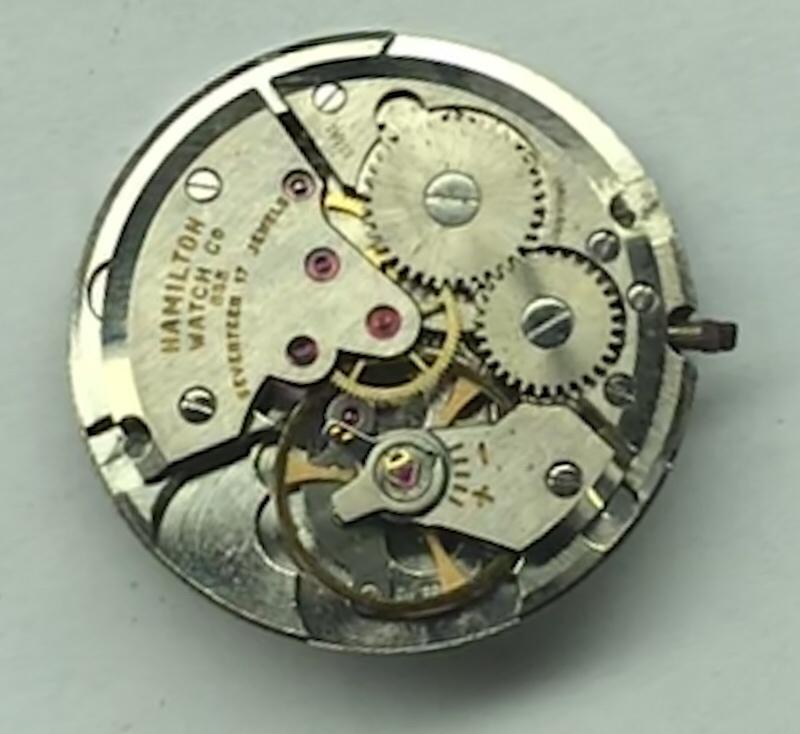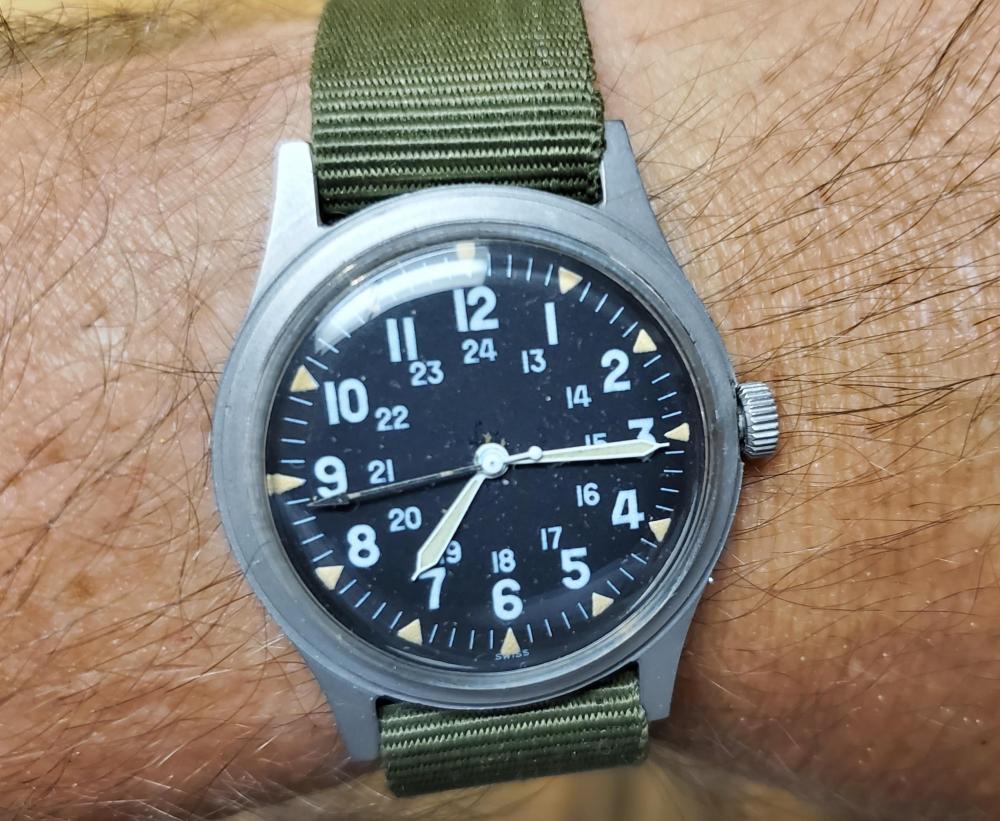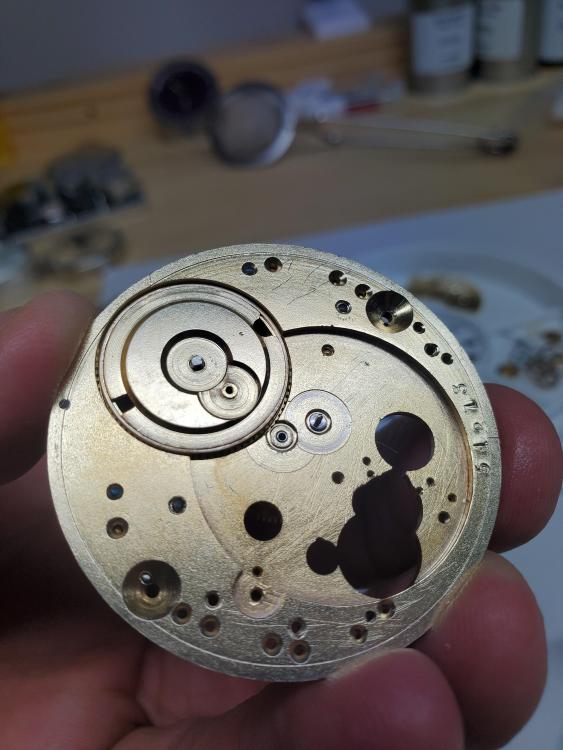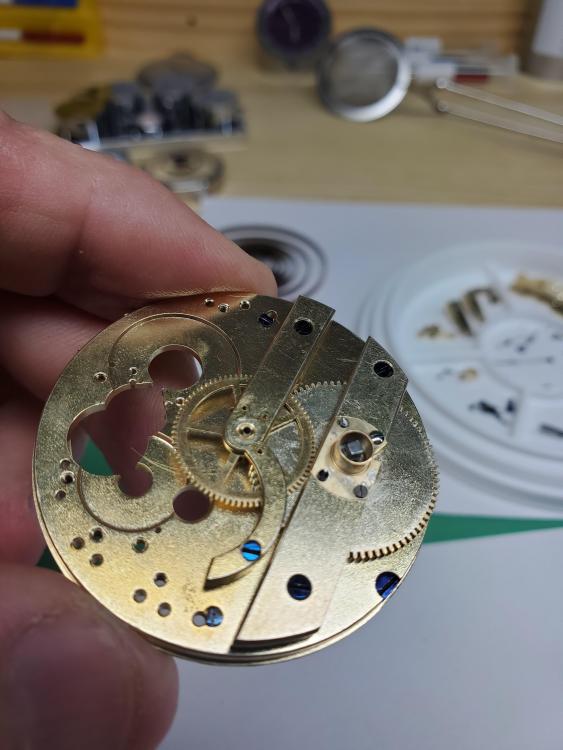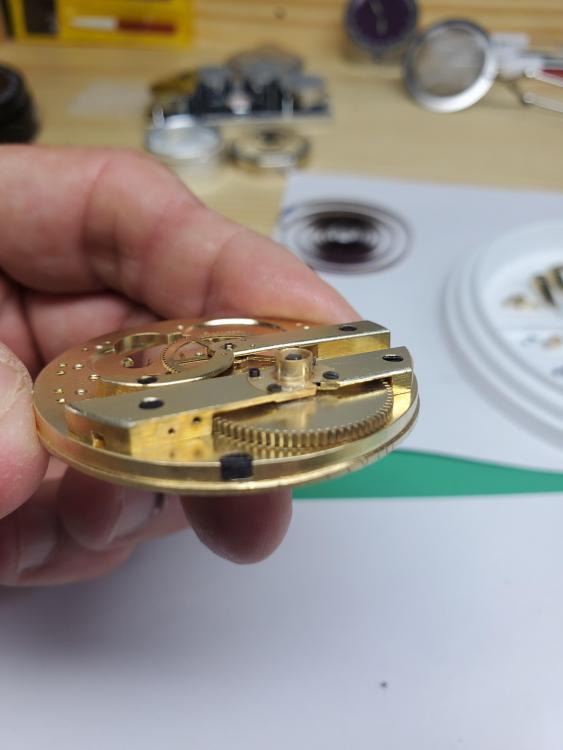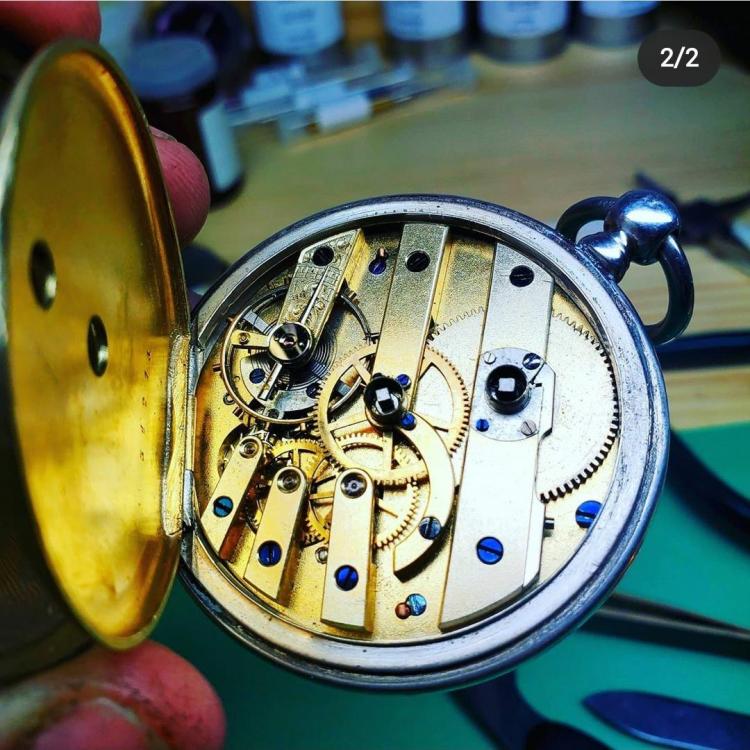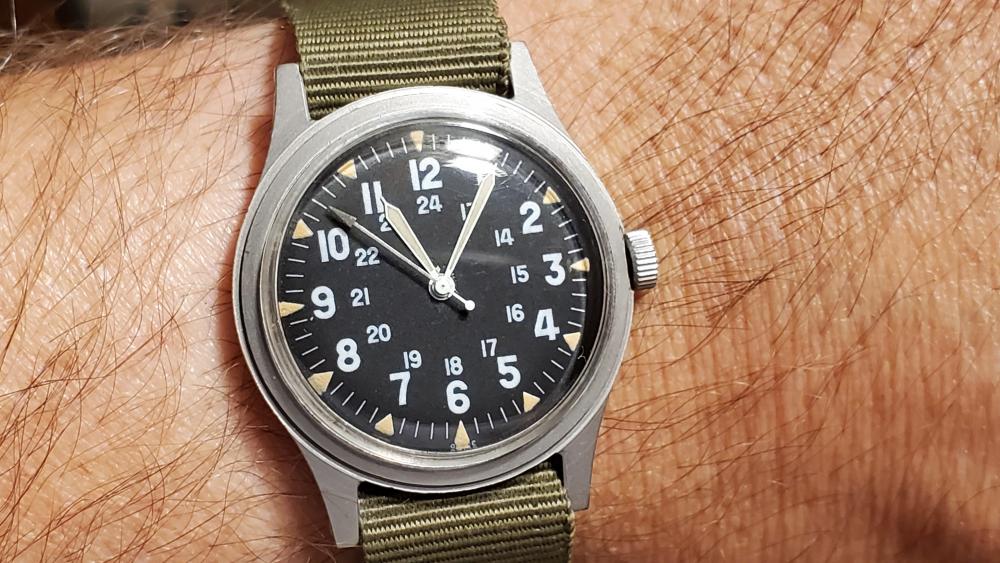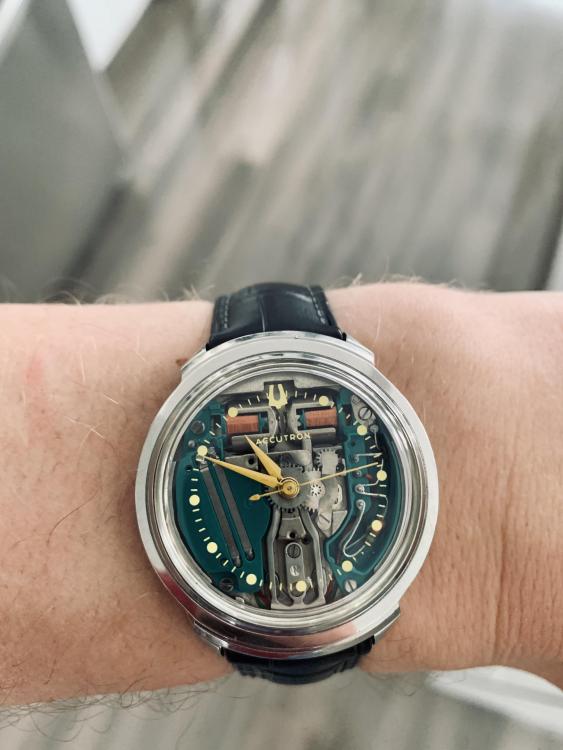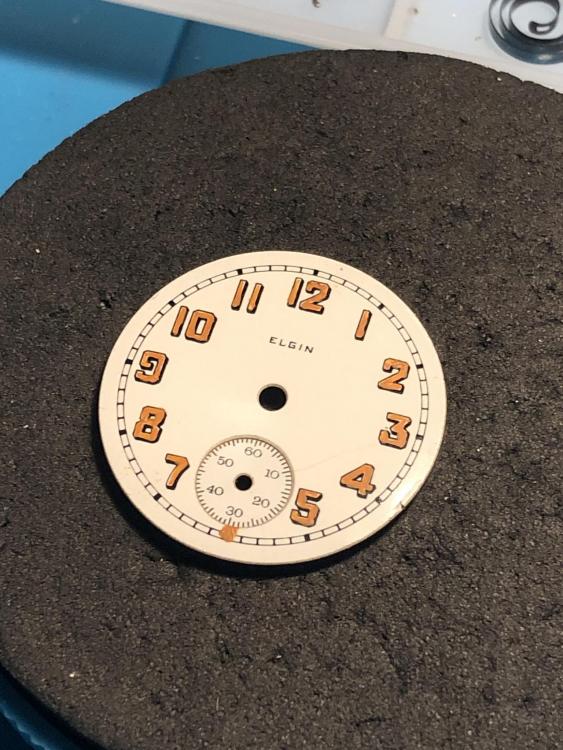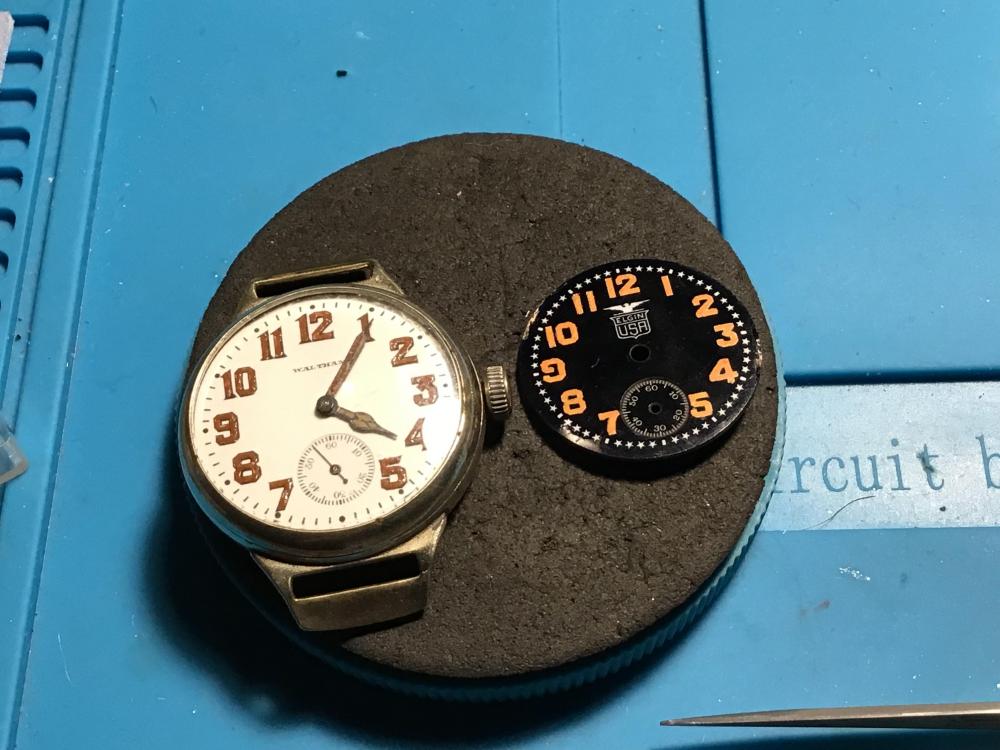Leaderboard
Popular Content
Showing content with the highest reputation on 05/27/20 in all areas
-
Working on a Hamilton 992 with a dirty dial. A fine cleaning with Rodico followed by targeted removal of spots and blotches with a toothpick; and then a cleanup with Rodico and Ta Da. And the movement was cleaned with Rodico as well. Being very careful not to touch the jewel holes. This PW has a swing of 540 Degrees. Sent from my iPhone using Tapatalk Pro3 points
-
2 points
-
The mainspring barrel is known as a suspended barrel as it only is attached on one side. I'm attaching a picture with some text to the image so you can see what it's supposed to look like. The way that it's supposed to be disassembled is you need to remove the barrel and then the arbor unscrews if you're lucky. The stop works mechanism is interesting in that watchmakers like to collect things. Rumor has it they steal the jewels out of your watch but that's not true but they do like to collect stop works mechanisms. Or the reality is they get confused at least that's one theory and don't know how to put It back together so they just don't. The watch will work fine without it. I've seen in the past where the solve the barrel wobbling problem dramatic modifications made in the dial side. Milling was done to the plate than a new plates inserted to support the barrel. Usually this always jumps out as just not looking right. So disassembling the barrel and possibly making a bushing providing the steel arbors not the problem which is unlikely.2 points
-
Thanks so much. That worked a treat and the new movement clicked right into it's place. I have replaced the hands and put a new 364 Energizer battery in and reassembled with the original crown and it is running beautifully. I have fitted a new original Ripcurl band I got off Ebay and am about to take it home to my wife to show her how clever I am! She will be thrilled as she is very fond of the watch as she bought it while our family was on a memorable holoday in Vanuatu about 13 years ago. Thanks again!2 points
-
Insert a safety razor in between the movement and dial, work it around the movement, wigle the blade to detach.2 points
-
Today I'm letting may father's US government issue GG-W-113 stretch it's legs. It has a genuine Hamilton 685 manual wind with hacking. I got this for him last year as a father's day gift. The date on the back of the case is June 1969, the year he was there, and exactly 50 years since he was there plus the month Father's day falls on. I can be thoughtful... No matter what my wife claims! It had random issues that I thought were minor, but then it flat quit on him. It has been on my bench since before Christmas waiting on me to troubleshoot it. Yesterday, I finally had some time to dig into it. Turns out the lower balance jewel Chaton had moved and just needed to be pressed back some. I had to guess as to how much to move it. Unfortunately I don't own a jewel press, very nerve wracking trying to push on the Chaton and not over do it. But it seems much better now, no stalling or anything. It's keeping excellent time. I gave the Crystal a better polish too. My first attempt was kinda half assed. So, I'll hang on to it and let it run down and sit for a week or so and wind it to see if it takes off. Fingers crossed.2 points
-
hi gang. I have this old swiss watch i bought and apon dismantling and cleaning i realizex two things. First it obviously had a geneva stop at birth which is no longer there. Unless someone else has a better idea what parts are missing. Im attaching fotos. The geneva is assembled on the outside of the barrel lid. The arbor for the geneva secondary wheel is missing as well. Second. The mainspring barrel arbor is only stablized on one side (the barrel bridge side). The dial is porcelain. I was hesitant to think the dial stablized the front pivot for the mainspring arbor. It doesnt. The barrel flops around with the dial on. The fotos are after the initial cleaning. I was checking for wear, polishing pivots, etc. This watch has an interesting time shaft which is friction fit into the minute wheel arbor. Its not pictured. The watch ran when i bought it. Im asking if anyone knows or has seen i watch movement set up this way? I cant seem to dismantle the arbor from the ratchet/ click wheel. I know it comes apart but i tried and i dont want to screw up anything without someones experienced advice. Thanks Steve1 point
-
I take a few pics and and make notes such as if screws are either reverse thread or longer than others. However the more you repair watches the less references are needed.1 point
-
Mark Lovick has posted an excellent video on mainspring choosing on Youtube. Worth a watch if you'll excuse the pun.1 point
-
Generic conversations on mainsprings can be an issue? Like using the term Vintage is interesting like what kind of vintage? So typically on mainsprings you need the with, thickness or strength and length. Then it depends on whether We are talking about a Swiss or American mainspring as mainsprings are interesting they can be measured in inches, metric and Dennison and conceivably the package will have all three. Then if it's vintage the end of the spring is important because the ends may be different depends on what were looking at. Then mainspring lubrication if the mainspring is the normal new either prelubricated or made out of a material a proper steel that doesn't need lubrication no lubrication is required including on the barrel wall. Unless of course it's an automatic mainspring Then your lubrication choice would be very very bad for that. So typically all you'd need to do is lubricate the arbor. Unless It is an automatic then Some form of breaking grease will be required and of course lubrication of the arbor. Then if we want to be generic about this if you know what the watch is you can look up what mainspring supposed to be in their. If it's a vintage watch there may be no listing then you have to take it out and measure it. If it's a standard Swiss mainspring usually can just push it in you don't need a Winder.1 point
-
For unfamiliar movements I take photography. In addition, on those with a variety of screws, I sometimes re-fit screws during disassembly. I often find screws swapped around on movements, especially when there are different lengths of screw with the same head. So: others don’t always get it correct.1 point
-
With me it was practice. Never took notes and never used a camera.1 point
-
The hook end of the mainspring, the outer end has attached a small tongue which will auto locate in the anchor position by means of a stop on the barrel wall, automatics have a bridle spring attached which locates against the barrel wall and slips when under max tension so as not to break the spring, hence the breaking grease on the wall. The details given by Rodabod are spot on usually Height X Thickness X Length X Barrel diameter.1 point
-
You can't miss the sound, hold the piece close to ears as when you hear the ticking, mainspring slipage sound is much louder.1 point
-
If I had started the 404 club pre-decimal would I have been looking at a £4 0s 9½d Club? Maybe not. Mind you I think four pound nine-pence hapn'y might have bought you are reasonably nice watch.1 point
-
I cant wait to get my florins. I really need to save some time because i am so behind with my many projects. I don't know what its secrets are, must be similar to "back to the future" stuff. Maybe if i take it apart....1 point
-
1 point
-
360 plus 180 Full swing. Amplitude is 1/2 that value Sent from my iPhone using Tapatalk Pro1 point
-
I remember my great aunt had one of these from the co-operative insurance well into the 1970's the insurance man would collect the money every quarter and log the amount in a payment book I also remember my grandma had a television that ran off 10 pence pieces to cover the cost of rental it would always go off half way through a program and every one would scramble around there pockets for 10p, the joys of life before direct debit.1 point
-
Yes, a floating barrel or “suspended barrel”. In the UK, the Geneva stopworks are regularly removed. Some watchmakers decided they were better without. For an excellent description of why they were implemented, David Boettcher’s website is excellent. https://www.vintagewatchstraps.com/blogstopwork.php1 point
-
I’d just like to add that what WW says is very relevant to this forum. Opinions do differ sometimes, and it can be hard to know sometimes what is best based on other opinions alone. In reality, you have to let experience decide for you in the long term. It may also be that your practical “style” defines how you work.1 point
-
1 point
-
Total arc of swing from extreme clockwise point to extreme anti-clockwise point is double the amplitude. So a swing of 540 degrees is an amplitude of 270 degrees.1 point
-
The way you're supposed to think of cleaning is that all of it is cleaning. the first bath has chemicals to dissolve the oils Remove oxides make the plates bright put things into the solution make things clean overly simplistic probably but it cleans. The rinse also continues to dissolve things into the solution and is technically cleaning. The other thing it is doing is reducing the concentration of the original solution. Which is why typically a cleaning solution followed by two separate rinses unless looking at the modern machines that might have three rinses. If you notice up above nickelsilver Posted that he's using isopropyl alcohol is his rinse actually has two of them. Then looks like were similar for clocks in that I use a commercial solution and follow up with hot running water then immediately in the alcohol. But I still don't have enough experience I've only cleaned a couple of clocks. Then it looks like the demineralized and distilled water is basically just really really clean water. Depending upon where you live the quality of water and its impurities plus the fluorides chlorine might be a problem. Then as far as ultrasonic goes it really doesn't have to be fancy. I started off with a small machine purchased from the drugstore don't think it cost very much money has really surprise was like why Outlook it's 20 and $30 like a century ago or something. Specifically designed where you're supposed to put a beaker into the ultrasonic which today everybody frowns on you shouldn't have anything directly on top of the transducer there should be a separation as bad things will supposedly happen. Except that machine ran for I don't even remember how many years a lot of years before it finally disintegrated. So it didn't seem to suffer any problems of having a beaker directly on top and then surrounded by water to couple the energy. Now if you scroll down the page at the link below I'm using a bigger ultrasonic and to keep everybody happy and not fuss the beaker is on something above the transducers surrounded by water. https://www.watchrepairtalk.com/topic/285-ultrasonic-cleaners/page/4/?tab=comments#comment-338031 point
-
Yes, It is very helpful in determining authentic GI issue watches. There seems to be a cottage industry of fake military watches. Mine is 100% authentic thankfully. I do wish I had the original carboard box it came in. I nearly manufactured one from scratch, but I gave up when I saw the work involved, lol. BTW... The photo I posted of the dial looks awful... Specs of dust on the Crystal That's better!1 point
-
The movement you are referring to is called " levet set ". Lever set watch had a pull out levet at about 1 o'clock. To set time remove just front of case, with finger nail pull out lever then with crown set time. After settling time push lever back in and then replace front, now crown will only wind watch. Search YouTube lever set watch and see many videos. A very good video of my mystery level at 3 oclock is on YouTube: staying sane video " 1917 Elgin 16s grade 293 assembly. at between 15 and 16 minutes into video Mr Sane clearly moves rim lever to what I call down position . This allows setting time using crown. I have asked Mr Sane what lever is for. Not sure in he will answer or knows answer, but I would bet he knew to move lever down. The movement in his video is same as mine.1 point
-
1 point
-
This Timex quartz diver cost me the exorbitant price of £1.99...... Now looks like this.... (the new crystal and bezel insert did put the total price up to about £12 or so though...)1 point
-
Reading the various websites and even the PDF all yield confusion? So cousins indicates ultrasonic with vacuum technology which are not going to have. But the next link I have another company specifically says for watches and is little more open on basically it's a general good cleaning solution. But look at the PDF and it's specifically says is for clockworks? So ignoring all the silly descriptions it looks like Elma WF Pro Is a good cleaning product and they indicate at least for clock works that the cleaning time should be: 2-10 min.Then a course you follow up with the same rinse you have at least two jars. Then you can just air dry with warm air even though it says you don't need warm air which page of just how to find out how it works for drying. Elma WF Pro Cleaner https://www.cousinsuk.com/product/elma-wf-pro-cleaner https://www.hswalsh.com/product/watch-cleaning-fluid-25-litre-elma-wf-pro-hf60911 point
-
@Marc & @AndyHull There is something stamped under the balance, but it's not legible at the available resolution. Looking at the Chaika 1301 movement, it's similar, but not quite... The barrel bridge extends out over the balance and the click is different (seems to be coming from beneath at 90° rather than the Chaika's more conventional co-planar arrangement), and the train is laid out differently. Mayhap it's one of the referenced variants? Is there that much variation within what would be considered a specific movement like that? The seller states that it's Swiss, but I have no idea what that's based on other than optimism or ignorance. @AndyHull As a former Rails web-dev (now on the hardware side), that's what came to mind. It's a high/low bar to try to achieve/slide under. I feel like it's one of those challenges you occasionally see in the more geeky corners of the internet. With luthiery, there's the "backyard challenge" where you have to build an instrument using only wood from within 50 miles of your home. With cars, it's LeMons; endurance racing with a $500 budget (excluding safety equipment) and a lot of making up for shortcomings with pageantry. And now with watches, there's "the 404 club" or the US chapter would be the "494 club" depending on exchange rates...1 point
-
There's a mark under the balance, but I can't make it out in the photo. It's the similar, but not quite the same watch at the top of the above photo based on the corners of the case, and I assume the rest are similar. The finish is odd, and that shock spring looks like one I keep seeing on French movements. Any ideas? https://i.ebayimg.com/images/g/XYkAAOSwh~xd3qFJ/s-l1600.jpg1 point
-
I seem to remember reading somewhere that one of the requirements for some railway time keepers was that the hands could only be set by removing the bezel to access a lever in the rim of the movement so that they couldn't be inadvertently altered. I don't recall any need to remove the dial though. Is it possible that this is a movement that has been recased and redialed using parts that don't accommodate this feature?1 point
-
Hi Gary you have recieved all shades of opinions and all relavant to the situation, If the old stem is serviceable by all means use that wish you well1 point
-
1 point
-
The "strength" sometimes an older term refers to the thickness. It is critical, whereas length is not absolutely critical. The reason is because the force developed follows a cube rule relative to the thickness. Ideally you'd use a micrometer, but a decent vernier caliper may suffice.1 point
-
Hello fellow watchmakers, in the photos attached you will see a white and black dial which was re lumed using pre mixed patina lume in a syringe nothing was added. It has the perfect matte powdery looking finish like vintage radium lume but color is too orange almost like a yellow ochre, i added instant coffee to the mix before application on the dial in the case, has a better color like a burnt sienna but it has a gloss to it. Iam not a fan of using varnish so I need to figure out a way to get the finish of the orange lume with a color more like burnt umber....as an artist umbers have a bit of green and them, so adding anything to the original mix gives a yellowish brown color. Radium lume looks more like burnt umber.....I was thinking of using match green tea powder with the original mix hoping it won’t add a sheen to it. When I search online all I hear about is coffee (which is usually added after application) and baking. I can’t bake a porcelain dial and coffee isn’t giving me what I need. I did hear someone using cigar ash or graphite anyone have any suggestions.....burnt umber color with a matte finish.1 point
-
Or, using this excellent forum to help you, learn how to DIY. Much more satisfying.1 point
-
I disagree with any test, wind, count with lid off and barrel in open. MS can come out flying and hurt someone. I grease or whatever you want to do, instal the barrel with retaining bridge and ratchet wheel screwed on. -- wind through the ratchet say with your screw driver, listen close for the sound of power discharge from the barrel (it will discharge at some point). You want to count the number turns on the ratchet wheel so mark a dot on the wheel and count the number of turn the dot goes by. Dispower the barrel fully, wind again, stop winding just short of the number you counted before power discharge. Let the watch run on bench and note how long it runs to stop. That is the actual power reserve your watch retains. The main advantage of this approach is, that you can still see with your eyes. Both of them. Regards1 point


